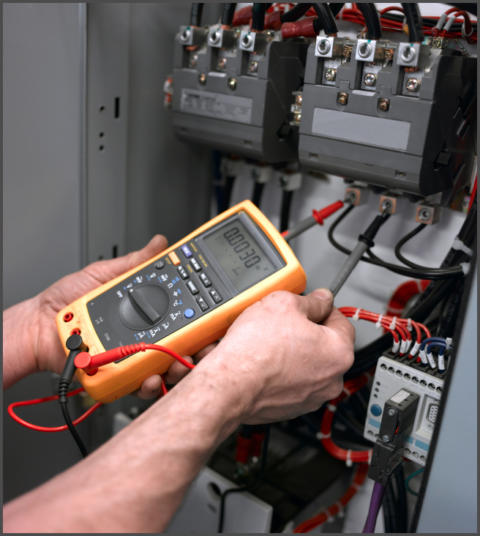Fixed Electrical Installation Periodic Inspection and Testing
Specification of Testing Procedures

Frequency of Testing
This will be in accordance with current Regulations and guidelines.
Sequence of Tests
For periodic Inspection and Testing, the following tests are generally applicable:
With the electrical supply disconnected, ie ‘Dead Tests’
- Continuity of protective conductors, main and supplementary bonding
- Continuity of ring final circuit conductors
- Insulation resistance
- Polarity
- Operation of devices for isolation and switching
- Site applied insulation (if applicable)
- Insulation of non conducting floors and walls (if applicable)
- Earth electrode resistance (if applicable)
With the electrical supply re-connected ie ‘Live Tests’
- Re-check polarity before testing continues any further
- Earth Fault loop impedance
- Prospective fault current
- Operation of Residual Current Devices (if applicable)
A visual inspection is to be carried out to verify that:
- The equipment used is in compliance with British Standards.
- It has been correctly selected and erected for the environment where it’s located and the installation meets current working practices.
- Ensure that the installation is not damaged or deteriorated so as to impair safety to persons or livestock
Continuity of Protective Conductors including main and supplementary bonding
Every protective conductor, including the earthing conductor, main and supplementary bonding conductors, should be tested to verify that the conductors are electrically sound and correctly connected. An insulation resistance/continuity tester or multi tester with the LOW resistance range selected should be used to carry out this test.
Continuity of ring final circuit conductors
A test is required to verify the continuity of each conductor including the circuit protective conductor (cpc) of every ring final circuit. The test results should establish that the ring is complete and has not been interconnected. An insulation resistance/continuity tester or multi tester with the LOW resistance range selected should be used to carry out this test.
Insulation resistance
These tests are to verify that for compliance with BS7671 the insulation of conductors and electrical accessories and equipment is satisfactory and that the live conductors or protective conductors are not short circuited, or show a low insulation resistance. These tests will be carried out between each live conductor and cpc and phase to phase for 3 phase circuits.
An insulation resistance/continuity tester or multi tester with the HIGH resistance range selected should be used to carry out this test.
Results obtained should be compared with the readings given in Table 61 in BS7671.
Polarity
The polarity of all circuits must be verified before connection to the supply and in the case of lighting circuits, ensure that all fuses and single pole switches are connected in the phase conductor. An insulation resistance/continuity tester or multi tester with the LOW resistance range selected should be used to carry out this test
Operation of devices for isolation and switching.
Where means are provided in accordance with the regulations for isolation and switching, they should be operated to verify their effectiveness and checked to ensure adequate and correct labeling. Easy access to said devices must be maintained and effective operation must not be impaired.
Site applied insulation
Site applied insulation is carried out ONLY where the insulation is applied DURING erection. They are not applied when type tested switch-gear is assembled on site. In most cases this test will be not applicable. The tests involve the use of high voltages and great care is necessary to avoid danger.
Insulation of non conducting floors and walls
Where protection against indirect contact is provided by a non conducting location, the tests as directed in 413-04 are to be implemented.
Earth electrode resistance
When measuring earth electrode resistance to Earth (Ra) where low values are required, as in the earthing of the neutral point of a transformer or generator, test method 1 should be used. If the electrode is being used in conjunction with an RCD, test method 2 may be applied as an alternative to test method 1. Test Method 1 uses an Earth Electrode Resistance Tester. Test Method 2 uses an EFLI meter.
Earth fault loop impedance
EFLI may be determined by either direct measurement or calculation based upon readings obtained for Ze and R1+R2. The tests must be completed at the points specified in BS7671. An EFLI meter or multi tester may be used with the LOW impedance range selected.
Prospective fault current
Generally this is provided by the test instrument at the time of the EFLI test, however it can be calculated by dividing the impedance reading Zs into the Nominal Voltage.
Operation of Residual Current Devices
In order to test the effectiveness of RCD’s, a series of tests must be applied to ensure they are within specification and operate satisfactorily. The procedure is as follows:
½ x IAN Test device should not trip. 1 x IAN Test device should trip within the stipulated time. 5 x IAN Test device should trip within the stipulated time. Note: Ensure that the test button is operational.
Documentation Used
The engineers will produce a test report and results electronically by way of BESPOKE Software and in accordance with BS7671. Any installation that is submitted to a Periodic Inspection and Test must have a Periodic Inspection report completed. All inspection and test results are to be recorded as indicated on the Periodic Inspection Report and serial numbers of test instruments used, operative name and date of test must also be recorded. The Technical Managers will verify the Test report and sign it off.
Distribution Boards
The following should be carried out:
Remove any old Periodic Inspection or Date Tested labels Apply New Date Tested Labels Ensure Voltage Warning Labels are in place Ensure RCD operation labels are in place if required Remove old and messy circuit identification labels Apply NEW circuit identification chart Customer Specific Requirements We will accommodate customer requirements where possible. Please provide details and we can quote accordingly.
Please contact us for any further information or a competitive quote.